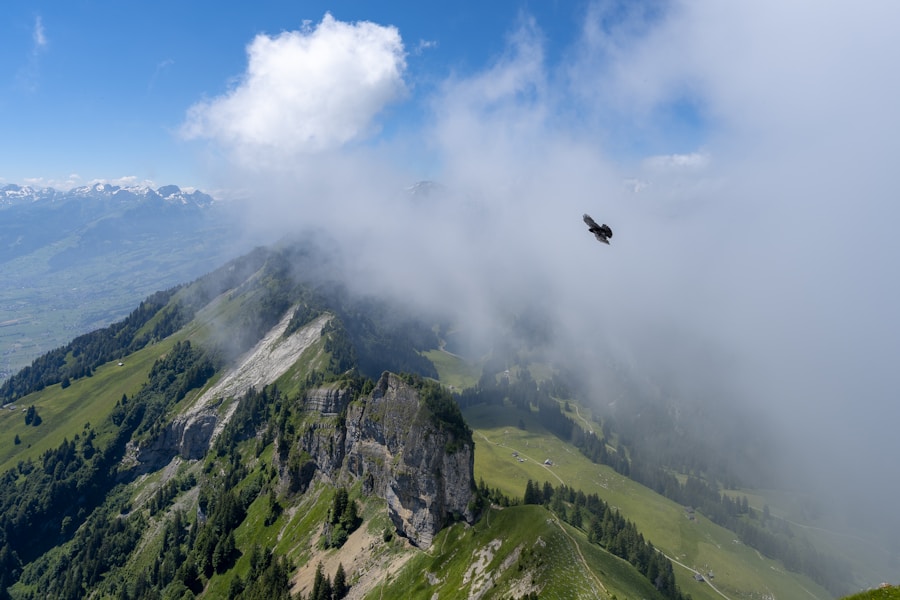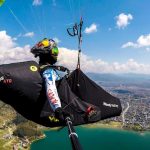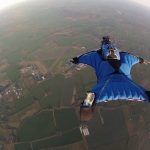Download links
How to install Soaring Through the Skies: The Thrill of Wingsuit Flying APK?
1. Tap the downloaded Soaring Through the Skies: The Thrill of Wingsuit Flying APK file.
2. Touch install.
3. Follow the steps on the screen.
Description
Wingsuit flying, a breathtaking sport that combines the thrill of skydiving with the grace of gliding, has its roots in the early 20th century. The concept of a suit designed to enhance human flight can be traced back to the pioneering work of aviation enthusiasts and inventors. One of the earliest recorded instances of a wingsuit-like apparatus was in 1912 when French aviator Franz Reichelt attempted to fly using a parachute suit he designed.
Unfortunately, his experiment ended tragically when he jumped from the Eiffel Tower, highlighting the inherent dangers of such ambitious endeavors. The modern wingsuit, however, began to take shape in the late 1990s. The first functional wingsuits were developed by a group of skydivers who sought to extend their freefall time and control their descent.
Notably, in 1998, the first wingsuit specifically designed for human flight was introduced by the company BirdMan, founded by skydiver and inventor Patrick de Gayardon. This suit featured fabric wings between the arms and legs, allowing pilots to glide through the air rather than simply plummeting toward the ground. The sport gained traction as more enthusiasts embraced the idea of flying like a bird, leading to a surge in wingsuit design and technology.
Key Takeaways
- Wingsuit flying originated from the idea of human flight and has evolved from early attempts in the 1930s to the modern sport it is today.
- The physics of wingsuit flying involves creating lift and drag to control the flight path, with the wingsuit acting as an airfoil to generate lift.
- The adrenaline rush of wingsuit flying comes from the intense speed and proximity to the ground, giving a sense of freedom and exhilaration.
- The risks of wingsuit flying include the potential for mid-air collisions, equipment malfunctions, and the need for strict safety measures and training.
- Becoming a wingsuit pilot requires extensive training in skydiving, canopy piloting, and wingsuit flying techniques, as well as physical and mental preparation.
- The future of wingsuit flying includes advancements in technology, safety equipment, and training methods to make the sport more accessible and safer for participants.
The Physics of Wingsuit Flying: How It Works
Understanding the physics behind wingsuit flying is essential for both enthusiasts and those curious about this exhilarating sport. At its core, wingsuit flying relies on the principles of aerodynamics. When a wingsuit pilot leaps from an aircraft, they enter a state of freefall, where gravity pulls them downward while air resistance pushes against their body.
The wingsuit’s design creates lift by increasing the surface area exposed to the airflow, allowing pilots to glide horizontally rather than simply falling straight down. The angle of attack is a critical factor in wingsuit flying. By adjusting their body position, pilots can manipulate this angle to control their speed and direction.
A higher angle of attack increases lift but also creates more drag, which can slow down the descent. Conversely, a lower angle of attack reduces lift but allows for faster speeds. This delicate balance is what enables experienced wingsuit pilots to navigate through canyons, over mountains, and even perform intricate aerial maneuvers.
The Adrenaline Rush: The Thrill of Wingsuit Flying

For many, wingsuit flying represents the ultimate adrenaline rush.
As pilots leap from an aircraft or a cliff, they are immediately enveloped in a rush of wind that heightens their senses and amplifies their excitement.
The feeling of weightlessness combined with the ability to control their flight path creates an exhilarating sense of freedom. The thrill is not just in the act of flying but also in the camaraderie shared among wingsuit pilots. Many enthusiasts form tight-knit communities where they share tips, experiences, and even travel together to explore new locations for jumps.
The social aspect adds another layer to the adrenaline experience, as pilots often push each other to try new tricks or explore challenging terrains. This sense of belonging and shared passion for flight enhances the overall thrill of wingsuit flying.
The Risks and Safety Measures of Wingsuit Flying
| Category | Risks | Safety Measures |
|---|---|---|
| Equipment | Equipment failure, such as parachute malfunction | Regular equipment checks, proper training in equipment use |
| Weather | Unpredictable weather conditions | Checking weather forecasts, avoiding flying in adverse conditions |
| Experience | Lack of experience leading to errors | Extensive training, mentorship from experienced wingsuit flyers |
| Health | Physical strain on the body | Regular exercise, medical check-ups, proper nutrition |
While wingsuit flying offers unparalleled excitement, it is not without its risks. The sport demands a high level of skill and experience, as even minor mistakes can lead to catastrophic consequences. Collisions with terrain or other flyers are among the most significant dangers faced by wingsuit pilots.
The proximity flying technique, where pilots navigate close to cliffs or trees, increases the risk factor exponentially. Inexperienced pilots may underestimate their ability to control their descent or misjudge distances, leading to accidents. To mitigate these risks, safety measures are paramount in wingsuit flying.
Pilots are encouraged to undergo extensive training and accumulate significant skydiving experience before attempting wingsuit flights. Many organizations recommend a minimum of 200 jumps before transitioning to wingsuits. Additionally, pilots often use specialized gear such as helmets equipped with cameras for recording their flights and altimeters for monitoring altitude.
Pre-jump briefings and thorough planning are also essential components of ensuring safety during flights.
Training and Preparation: What It Takes to Become a Wingsuit Pilot
Becoming a proficient wingsuit pilot requires dedication, rigorous training, and a solid foundation in skydiving techniques. Aspiring pilots typically start with traditional skydiving lessons, where they learn essential skills such as freefall positioning, parachute deployment, and emergency procedures. This foundational training is crucial because it instills confidence and familiarity with the dynamics of freefall before introducing the complexities of wingsuit flying.
Once a skydiver has achieved sufficient experience, they can begin transitioning to wingsuits through specialized training programs offered by various organizations. These programs often include ground school sessions that cover wingsuit aerodynamics, body positioning, and flight techniques. Additionally, supervised jumps with experienced instructors allow new pilots to practice their skills in a controlled environment.
This gradual approach ensures that pilots develop the necessary competencies before embarking on solo flights.
The Future of Wingsuit Flying: Innovations and Advancements

As technology continues to evolve, so too does the world of wingsuit flying. Innovations in materials and design have led to lighter and more aerodynamic suits that enhance performance and safety. For instance, advancements in fabric technology have resulted in suits that offer better lift-to-drag ratios while remaining durable enough to withstand the rigors of high-speed flight.
These improvements not only enhance the flying experience but also contribute to increased safety margins for pilots. Moreover, the integration of technology into wingsuit flying is paving the way for new possibilities. The use of GPS tracking systems allows pilots to monitor their flight paths in real-time, providing valuable data for performance analysis and safety assessments.
Additionally, virtual reality (VR) training tools are emerging as effective methods for teaching aspiring wingsuit pilots about body positioning and flight dynamics without the risks associated with actual jumps. As these innovations continue to develop, they promise to shape the future landscape of wingsuit flying, making it more accessible and safer for enthusiasts around the globe. In conclusion, wingsuit flying is a captivating blend of history, physics, thrill-seeking adventure, and technological advancement.
From its origins rooted in early aviation experiments to its current status as an extreme sport embraced by many around the world, it represents humanity’s enduring fascination with flight. As innovations continue to emerge and safety measures evolve, wingsuit flying will likely attract even more enthusiasts eager to experience the unparalleled freedom of soaring through the skies.
FAQs
What is wingsuit flying?
Wingsuit flying is a skydiving discipline where participants wear a special jumpsuit that adds surface area to the body, enabling them to glide through the air.
How does a wingsuit work?
A wingsuit works by creating additional surface area with fabric between the arms and body, as well as between the legs. This allows the wearer to generate lift and glide through the air.
What are the risks of wingsuit flying?
Wingsuit flying carries inherent risks, including the potential for collisions with obstacles, parachute malfunctions, and the need for precise flying skills. It is considered an extreme sport and should only be attempted by experienced skydivers.
What training is required for wingsuit flying?
To participate in wingsuit flying, individuals must first become certified skydivers and gain experience in traditional skydiving. They then undergo specialized wingsuit training to learn the skills necessary for safe and controlled flight.
Where can wingsuit flying be practiced?
Wingsuit flying is typically practiced at designated skydiving drop zones or in locations with suitable terrain for safe landing. Some locations are specifically known for their wingsuit flying opportunities, such as the Swiss Alps or other mountainous regions.





